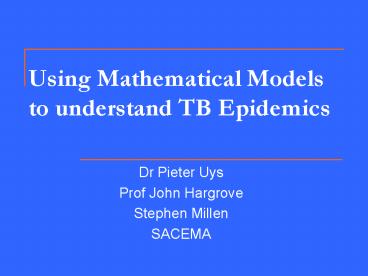Using Mathematical Models to understand TB Epidemics PowerPoint PPT Presentation
1 / 15
Title: Using Mathematical Models to understand TB Epidemics
1
Using Mathematical Models to understand TB
Epidemics
- Dr Pieter Uys
- Prof John Hargrove
- Stephen Millen
- SACEMA
2
TB 101
- TB agent mycobacterium tuberculosis
- Airborne droplets enter lungs
- Disease immediate or possibly latent
3
The bacterium
Thin section transmission electron
micrograph Source http//www.wadsworth.org/databa
nk/hirez/mcdonp4.gif
- Bacteria revealed using acid-fast Ziehl-Neelsen
stain Magnified 1000 X. - Source CDC-PHIL ID 5789
4
Extent of the problem
- Over one-third of the world's population carries
the TB bacterium. Not everyone infected develops
the full-blown disease, so asymptomatic, latent
TB infection is most common. However, 10 of
latent infections progress to active TB disease,
which, if left untreated, kills more than half of
its victims.
5
- In 2004, mortality and morbidity statistics
included 14.6 million chronic active TB cases,
8.9 million new cases, and 1.6 million deaths,
mostly in developing countries. Increasingly,
people in the developed world are contracting
tuberculosis because their immune systems are
compromised by e.g. HIV/AIDS.
6
- The rise in HIV infections and the neglect of TB
control programs have enabled a resurgence of
tuberculosis. The emergence of drug-resistant
strains has also contributed to this new epidemic
with, from 2000 to 2004, 20 of TB cases being
resistant to standard treatments and 2 resistant
to second-line drugs.
7
TB Incidence per 100 000
8
Mathematical modelling of a TB epidemic
- Based on the SEIR framework
Susceptible
infEcted
Infectious
Recovered
9
Model for susceptible and resistant TB, with
reinfection
Model is represented by a system of differential
equations and investigated by computer simulations
10
Annual costs of treating susceptible cases and
MDR cases
11
The Impact of the Delay Time
12
- To achieve control of a TB epidemic, at no time
prior to diagnosis should the value of
exceed
13
So what can be done to reduce delay to diagnosis?
- What factors contribute to the delay?
Need to examine the various scenarios from onset
of symptoms to eventual diagnosis and start of
therapy
14
- Delay in deciding to visit a health care provider.
May visit a health care provider who has no
facility for testing for TB
Delay in getting to a health care provider who
does test for TB
He may be treated for the cough, but not for TB,
and discharged. A CXR may be taken. A sputum
sample may be taken, and further samples
requested
15
- The delay in the start of treatment, in the event
that the patient tests positive.
The delay arising from the time it takes the
laboratory to examine the sputa.
The delay in the patient returning to get the
result, once all of the sputum samples have been
provided.
Although a patient may have TB, the test may,
nonetheless, return a negative result. The
result is a function of the sensitivity of the
test
Same considerations apply to CXRs

